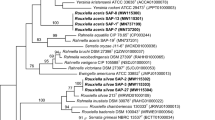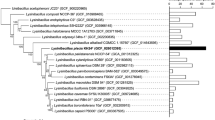Abstract
Eight strains isolated from birds, reptiles, and water constitute a new DNA hybridization group that is 37–58% related toEdwardsiella tarda and less than 10% related to other species of Enterobacteriaceae (SI nuclease method). This homogeneous group (78–100% relatedness within the group) constitutes a new species that is namedEdwardsiella hoshinae sp. nov. (type strain, CIP 78.56 ATCC 33379). Strains of this species produce acid fromd-mannitol, sucrose,d-trehalose, and salicin, and give a positive malonate test. Seven other strains that produced acid fromd-mannitol and sucrose (but not fromd-trehalose and salicin) and were malonate negative were found to belong to theEdwardsiella tarda DNA hybridization group. The base composition of the DNAs ofE. tarda andE. hoshinae is 55–58 mol% G+C.
Similar content being viewed by others
Literature Cited
Brenner, D. J., Farmer, J. J., III, Fanning, G. R., Steigerwalt, A. G., Klykken, P., Wathen, H. G., Hickman, F. W., Ewing, W. H. 1978. Deoxyribonucleic acid relatedness ofProteus andProvidencia species. International Journal of Systematic Bacteriology28:269–282.
Brenner, D. J., Fanning, G. R., Johnson, K. E., Citarella, R. V., Falkow, S. 1969. Polynucleotide sequence relationships among members of theEnterobacteriaceae. Journal of Bacteriology98:637–650.
Brenner, D. J., Fanning, G. R., Skerman, F. J., Falkow, S. 1972. Polynucleotide sequence divergence among strains ofEscherichia coli and closely related organisms. Journal of Bacteriology109:953–965.
Brenner, D. J., Fanning, G. R., Steigerwalt, A. G. 1974. Polynucleotide sequence relatedness inEdwardsiella tarda. International Journal of Systematic Bacteriology24:186–190.
Brenner, D. J., Steigerwalt, A. G., Falcão, D. P., Weaver, R. E., Fanning, G. R. 1976. Characterization ofYersinia enterocolitica andYersinia pseudotuberculosis by deoxyribonucleic acid hybridization and by biochemical reactions. International Journal of Systematic Bacteriology26:180–194.
Crosa, J. H., Brenner, D. J., Falkow, S. 1973. Use of a single-strand specific nuclease for analysis of bacterial and plasmid deoxyribonucleic acid homo- and heteroduplexes. Journal of Bacteriology115:904–911.
Edwards, P. R., Ewing, W. H. 1972. Identification ofEnterobacteriaceae, 3rd ed. Minneapolis: Burgess.
Ericsson, H. M., Sherris, J. C. 1971. Antibiotic sensitivity testing: Report of an international collaborative study. Acta Pathologica et Microbiologica Scandinavica, Suppl.217:64–71.
Ewing, W. H., McWhorter, A. C., Escobar, M. R., Lubin, A. H. 1965.Edwardsiella, a new genus ofEnterobacteriaceae based on a new species,E. tarda. International Bulletin of Bacteriological Nomenclature and Taxonomy15:33–38.
Farmer, J. J., III, Brenner, D. J., Clark, W. A. 1976. Proposal to conserve the specific epithettarda over the specific epithetanguillimortiferum in the name of the organism presently known asEdwardsiella tarda. Request for an opinion. International Journal of Systematic Bacteriology26:293–294.
Grimont, P. A. D., Grimont, F., Starr, M. P. 1979.Serratia ficaria sp. nov., a bacterial species associated with Smyrna figs and the fig waspBlastophaga psenes. Current Microbiology2:277–282.
Grimont, P. A. D., Grimont, F., Dulong de Rosnay, H. L. C., Sneath, P. H. A. 1977. Taxonomy of the genusSerratia. Journal of General Microbiology98:39–66.
Grimont, P. A. D., Grimont, F., Starr, M. P. 1978.Serratia proteamaculans (Paine and Stansfield) comb. nov., a senior subjective synonym ofSerratia liquefaciens (Grimes and Hennerty) Bascomb et al. International Journal of Systematic Bacteriology28:503–510.
Grimont, P. A. D., Popoff, M. Y., Grimont, F., Coynault, C., Lemelin, M. 1980. Reproducibility and correlation study of three deoxyribonucleic acid hybridization procedures. Current Microbiology4:325–330.
Hoshina, T. 1962. On a new bacterium,Paracolobactrum anguillimortiferum n. sp. Bulletin of the Japanese Society of Scientific Fisheries28:162–164.
Johnson, R., Colwell, R. R., Sakazaki, R., Tamura, K. 1975. Numerical taxonomy study of theEnterobacteriaceae. International Journal of Systematic Bacteriology25:12–37.
King, B. M., Adler, D. L. 1964. A previously undescribed group ofEnterobacteriaceae. American Journal of Clinical Pathology41:230–232.
Owen, R. J., Hill, L. R., Lapage, S. P. 1969. Determination of DNA base compositions from melting profiles in dilute buffers. Biopolymers7:503–516.
Richard, C. 1972. Methode rapide pour l'étude des réactions de rouge de méthyle et Voges-Proskauer. Annales de l'Institut Pasteur122:979–986.
Richard, C. 1978. Techniques de recherche d'enzymes utiles au diagnostic de bactéries á Gram négatif. Annales de Biologie Clinique36:407–424.
Sakazaki, R. 1965. A proposed group of the familyEnterobacteriaceae, the Asakusa group. International Bulletin of Bacteriological Nomenclature and Taxonomy15:45–47.
Sakazaki, R. 1974. Genus II.Edwardsiella Ewing and McWhorter 1965, 37, p. 296. In: Buchanan, R. E., Gibbons, N. E. (eds.), Bergey's manual of determinative bacteriology, 8th ed. Baltimore: Williams & Wilkins.
Sakazaki, R., Tamura, K. 1975. Priority of the specific epithetanguillimortiferum over the specific epithettarda in the name of the organism presently known asEdwardsiella tarda. International Journal of Systematic Bacteriology25:219–220.
Sakazaki, R., Tamura, K. 1978. Comment on a proposal of Farmer et al. to conserve the specific epithettarda over the specific epithetanguillimortiferum in the name of the organism known asEdwardsiella tarda. International Journal of Systematic Bacteriology28:130–131.
Sutton, W. D. 1971. A crude nuclease preparation suitable for use in DNA reassociation experiments. Biochimica et Biophysica Acta240:522–531.
Véron, M. 1975. Nutrition et taxonomie desEnterobactericceae et bactéries voisines. I. Méthode d'étude des auxanogrammes. Annales de Microbiologie126A:267–274.
Author information
Authors and Affiliations
Rights and permissions
About this article
Cite this article
Grimont, P.A.D., Grimont, F., Richard, C. et al. Edwardsiella hoshinae, a new species of enterobacteriaceae. Current Microbiology 4, 347–351 (1980). https://doi.org/10.1007/BF02605375
Issue Date:
DOI: https://doi.org/10.1007/BF02605375




